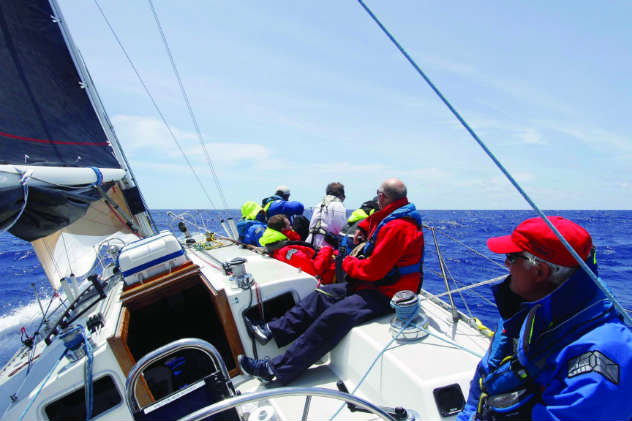Expert Advice on Safety Briefings
Standard practice with novice crew members and non-sailing guests is for the captain to give a safety briefing before leaving the dock. As well as a better informed crew about safety and what to do in an emergency, a good safety briefing will help ease the minds of the skipper, as well as the newbies or those unfamiliar with the boat.

Renee Mehl, who is the director of the U.S. Naval Academy’s Offshore Sail Training Program, a seasoned offshore racer, round-the-world racer, and cruiser helped us to compile a pre-departure safety briefing with 12 tips. Mehl says that a few items below may not be relevant, depending on the type of boat you have, but if you want your guests aboard to participate in the day’s activities, brief them and/or demonstrate the following:
1. Explain how to safely get aboard.
Pull the boat close to the dock with the bow line. Put one foot outside lifelines, and then step over with the other foot while holding onto the shrouds, spinnaker halyard, or inner forestay. Look at the winch to make sure the line is made fast if grabbing a halyard. Have someone pull the boat over to the dock to disembark; use the same sequence: one foot over lifeline onto the rail, the other foot all the way to the stairs or dock.
2. Pass over any heavy items before or after boarding.
Goes without saying. Balance + Steping on a boat with heavy items = no bueno.
3. Know how to call for help.
Tell your guests how to call for help on channel 16 with your VHF radio turned on. If you have a DSC-VHF radio, show them the red mayday button and explain how to activate it. If the boat has a GPS, briefly mention how to read the lat/long in case the guest has to make an emergency call on the VHF. Show your guests on a chart where you’re going and estimate when the group should be returning.
4. Be aware of medical issues.
Ask if there are any medical issues the skipper should be aware of, such as the need for an EpiPen or heart medications. Guests can talk to the skipper privately after the initial safety brief.
5. Gear up.
Bring out the lifejackets, and encourage your new-to-boating guests to wear one. Explain how inflatable PFDs work. If they are not worn, ensure they are easy to get to. Point out the location of other important safety gear such as flares and fire extinguishers.
6. Overboard Safety.
Let your crew know what to do if someone falls overboard. Having a spotter is essential, as is keeping a throwable device, such as the lifering, self-inflating SOS Dan Buoy, or PFD handy at all times.

7. Set expectations.
Explain to your guests where the best/safest places are to sit during sailing, and if the boat is on the small side, show them how a passenger’s shifting weight can affect your boat’s stability or exposure to waves. Explain that the boat ‘tipping over’ is a natural part of sailing.
8. Mention the parts and aspects of the boat that can hurt you.
The boom, vang, hatches where one could fall down, and the danger of grabbing onto running rigging or a loaded line, instead of a solid handhold such as the lifelines or rail. Explain the boom (and mainsheet) will move while underway and to keep their heads low, especially in wavy or stormy conditions and with heavy powerboat chop. Point out danger area for gybes, between the primary winch and base of mainsheet.
9. Make your crew aware.
Announce, loudly, when the forward hatch is open to get or stow sails, especially at night. The main companionway hatch should be closed whenever anyone is working on the cabintop (raising or lowering the mainsail or taking/shaking reefs), or if the ladder is removed to do engine checks.
10. Encourage guests to help sail the boat.
Review the dangers of stepping on lines that may move while tacking, gybing, or jumping a halyard, especially if they’re standing in a bight or loop of line that may tension if tightened. There are also dangers with tailing or lowering a halyard: if the wraps come off and you’re not wearing gloves, the instinct is to grab the rope, resulting in a painful rope burn.
At the winches, always handle lines with thumbs pointing inward so that they don’t get caught between the drum and the line.
11. Always handle the bitter end of a dock line onboard.
Especially when pulling in through a closed chock. Danger: if fingers are through a bight or loop of line coming through a closed chock, and the boat surges, fingers can get crushed.
12. Have an informal debrief.
A great way to wrap up a fun day on the water with your newly minted sailors is to have an informal debrief, and ask them what they learned. You might be on the way to developing experienced future crew, refine your own briefing items, and help grow their interest in our sport!
By Carrie Gentile
This is the second part in our 2019 Safety Series. Find the first part here.




